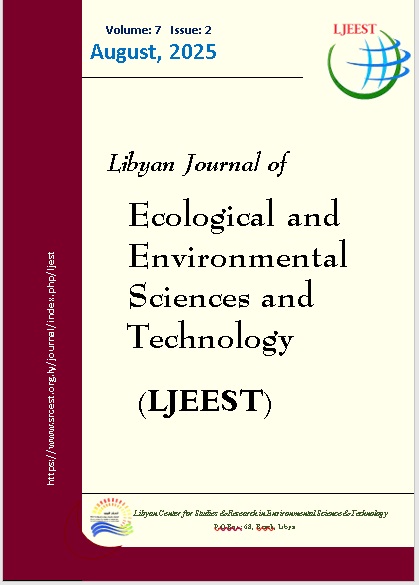Physicochemical and Biological Properties of Some Internal Valleys Soil in Wadi Al-Shatii, Libya
DOI:
https://doi.org/10.63359/jftmqt82Keywords:
Entisols Newly formed soils, electrical conductivity, microbial activity, organic matter, water retentionAbstract
Newly formed Entisols are prevalent in the topographically lower regions of the Wadi Al-Shati basin. As immature soils, they are characterized by low nutrient content essential for plant growth. The quantity and quality of these nutrients are significantly influenced by the soil's physicochemical and biological properties, such as texture, structure, bulk and particle density, and porosity. Consequently, these properties directly impact the basin's biodiversity and vegetative cover. Understanding these characteristics provides crucial insight into their positive or negative effects on the diversity and density of plant life. Soil properties vary with location, while geological, topographical, climatic, and hydrological conditions play a vital role in determining their physicochemical and biological attributes. Studying the soil characteristics of these internal wadi channels in the Wadi Al-Shati region is essential for identifying their potential as a sustainable natural resource. A scientific approach is necessary to improve, maintain, and conserve these soils, ensuring their long-term viability. This study aims to determine the physicochemical and biological characteristics of the soils within two internal wadi channels in Wadi Al-Shati, Libya: Wadi Tarut and Wadi Ququm. The results revealed significant differences in the soil properties of the two wadis. The percentage of organic matter in Wadi Tarut ranged from 1.2% to 2%, while in Wadi Ququm, it ranged from 1.3% to 2.8%. Similarly, particle density varied, measuring between 2.3 and 2.7 g/cm³ for Wadi Tarut and 2.3 and 2.8 g/cm³ for Wadi Ququm. Differences were also noted in water retention capacity, which ranged from 10.6% to 14% in Wadi Tarut and 9.4% to 15% in Wadi Ququm. Both wadis exhibited high electrical conductivity values, with Wadi Tarut soils ranging from 24.5 to 84.4 dS/m⁻¹ and Wadi Ququm soils from 4.20 to 10.60 dS/m⁻¹. The pH was nearly neutral in both wadis, ranging from 6.9 to 7.3 for Wadi Tarut and 7.2 to 7.6 for Wadi Qumqum. Sodium ion concentrations were elevated, ranging from 4.8 to 39.00 mg/L in Wadi Tarut and 14.6 to 36.00 mg/L in Wadi Qumqum. Potassium content in Wadi Tarut was between 3 and 35.2 mg/L, while in Wadi Qumqum, it ranged from 5.8 to 9.00 mg/L. The findings of this study lead to the conclusion that the environmental conditions of these two internal wadis, such as extreme aridity and high salinity, act as selective pressures, allowing only plant species capable of adapting to these harsh conditions to thrive.
References
Abdelfattah, M. A., Shahid, S. A., & Othman, Y. R. (2009). Soil salinity mapping model developed using RS and GIS—a case study from Abu Dhabi, United Arab Emirates. European Journal of Scientific Research, 26(3), 342-351. https://doi.org/10.2136/sh2009.1.0003
Adams, M. B., Peterjohn, W. T., & Gilliam, F. S. (2006). Acidification and nutrient cycling. In The Fernow watershed acidification study (pp. 207-236). Dordrecht: Springer Netherlands. https://doi.org/10.1007/1-4020-4615-4_7
Aishah, M. R., Alshebani, A. K., Romdan, A. A., & Panhwar, Q. A. (2022). Using different organic wastes to improve the quality of desert soils and barley (Hordeum vulgare) plant growth. Int. J. Sci. Res. Arch, 6, 193-205 .https://doi.org/10.30574/ijsra.2022.6.2.0161
Aishah, R. M. and Elssaidi, M. A. (2020). Soil and Water Physical & Chemical Properties of Tragen Sabkha Area, Southwest Libya. Sciences 35 (1): 46-59 . https://doi.org/10.2166/wpt.2024.163
Aishah, R. M., & Elssaidi, M. A. (2019). Using Pollution Indices to Assess Heavy Metals Contaminated Soil in some Libyan Regions. Libyan Journal of Ecological & Environmental Science and Technology (LJEEST), 1(1), 38-49. https://doi.org/10.63359/xscykm31
Alam, M. Z., Das, D. K., Hashem, M. A., & Hoque, M. A. (2016). Soil amendments with farm yard manure and poultry manure confer tolerance to salt stress in rice (Oryza sativa L.). Research in Agriculture Livestock and Fisheries, 3(3), 379-386. https://doi.org/10.3329/ralf.v3i3.30728
Albireeki, M. H., Soliman, M. S., & Mohamed, A. R. (2019). Effect of Sodium Fluoride on Germination Seedling Growth in Wheat (Triticum aestivum) VAR UP2382. Libyan Journal of Ecological & Environmental Science and Technology (LJEEST)1(1), 25-33. https://doi.org/10.63359/tqkn4t09
Barik, T., Behera, B., Jena, S. N., Roul, P. K., & Satapathy, M. R. (2015). Crop nutrition and productivity of maize and cowpea intercropping system under different management practices. E planet, 13(2), 37-44. https://doi.org/10.56739/jor.v37ispecialissue.140812
Baruah, T.C. and Barthakur, H.P. 1997. A textbook on Soil Analysis. Vikas Publishing House PVT LTD, 576 Masjid Road, Jangpura, New Delhi 110 014. https://doi.org/10.1163/157254397x00115
Braun-Blanquet, J., Roussine, N., & Nègre, R. (1951). The plant communities of Mediterranean France. CNRS, Paris. https://doi.org/10.1080/12538078.2015.1108868
Chi, Z., Wang, W., Li, H., Wu, H., & Yan, B. (2021). Soil organic matter and salinity as critical factors affecting the bacterial community and function of Phragmites australis dominated riparian and coastal wetlands. Science of The Total Environment, 762, 143156. https://doi.org/10.1016/j.scitotenv.2020.143156
Demmig‐Adams, B., & Adams III, W. W. (2006). Photoprotection in an ecological context: the remarkable complexity of thermal energy dissipation. New phytologist, 172(1), 11-21. https://doi.org/10.1111/j.1469-8137.2006.01835.x
Eusufzai, M. and Fujii, K. (2012) Effect of Organic Matter Amendment on Hydraulic and Pore Characteristics of a Clay Loam Soil. Open Journal of Soil Science, 2, 372-381. https://doi.org/10.4236/ojss.2012.24044
Eusufzai, M. K., &, K. (2012). Effect of organic matter amendment on hydraulic and pore characteristics of a clay loam soil. https://doi.org/10.4236/ojss.2012.24044
Farida, Y.M and Aishah, R. M.,( 2023): Phytoremediation of Salinity Affected Soils. Libyan Journal of Ecological & Environmental Sciences and Technology (LJEEST), June, 2024
Hillel, D., & Hatfield, J. L. (Eds.). (2005). Encyclopedia of Soils in the Environment (Vol. 3). Amsterdam, The Netherlands: Elsevier. https://doi.org/10.1016/b0-12-348530-4/90035-3
Kamal, A., Ahmad, M. S. A., Alvi, A. K., Hameed, M., Ahmad, F., & Ghaffar, K. (2021). Soil salinity differentially influences soil physicochemical properties and nutrient availability in rhizospheric soils of grasses growing in hyper-saline-arid regions. Soil & Environment, 40(1). https://doi.org/10.1080/15324989709381487
Laity, J. J. (2009). Deserts and desert environments (Vol. 3). John Wiley & Sons. https://doi.org/10.1111/j.1475-4959.2009.00347_6.x
Lymbery, A. J., Kay, G. D., Doupé, R. G., Partridge, G. J., & Norman, H. C. (2013). The potential of a salt-tolerant plant (Distichlis spicata cv. NyPa Forage) to treat effluent from inland saline aquaculture and provide livestock feed on salt-affected farmland. Science of the Total Environment, 445, 192-201. https://doi.org/10.1111/geoj.2009.175.issue-4
Manlay, R. J., Feller, C., & Swift, M. J. (2007). Historical evolution of soil organic matter concepts and their relationships with the fertility and sustainability of cropping systems. Agriculture, Ecosystems & Environment, 119(3-4), 217-233. https://doi.org/10.1016/j.agee.2006.07.011
Meena, M. (2023). A Geographical Study of Deserts. European journal of innovation in nonformal education, 3(7), 219-238. https://doi.org/10.15294/jne.v9i1.42720
Munsell, A. H. (2000). Munsell soil color charts. Gretagmacbeth. https://doi.org/10.5040/9781501327551.0006
Paudel, S., & Vetaas, O. R. (2014). Effects of topography and land use on woody plant species composition and beta diversity in an arid Trans-Himalayan landscape, Nepal. Journal of Mountain Science, 11, 1112-1122. https://doi.org/10.1007/s11629-013-2858-3
Perie, C., & Ouimet, R. (2008). Organic carbon, organic matter and bulk density relationships in boreal forest soils. Canadian journal of soil science, 88(3), 315-325. https://doi.org/10.4141/cjss06008
Piper, J. (1987). Interaction forces between soil particles: shear moduli of the< 2 μm size fraction. Journal of Soil Science, 38(1), 1-11. https://doi.org/10.1111/j.1365-2389.1987.tb02117.x
Riaz, U., Murtaza, G., Saifullah, F. M., & Farooq, M. (2018). Comparable effect of commercial composts on chemical properties of sandy clay loam soil and accumulation of trace elements in soil-plant system. Int J Agric Biol, 20(1), 85-92. https://doi.org/10.1002/ldr.2925
Rice, E. W., Bridgewater, L., & American Public Health Association (Eds.). (2012). Standard methods for the examination of water and wastewater (Vol. 10). Washington, DC: American public health association. https://doi.org/10.1002/j.1551-8833.1932.tb18153.x
Rivenshield, A., & Bassuk, N. L. (2007). Using organic amendments to decrease bulk density and increase macroporosity in compacted soils. Arboriculture and Urban Forestry, 33(2), 140. https://doi.org/10.48044/jauf.2007.015
Rump, H. H., & Krist, H. (1988). Laboratory manual for the examination of water, waste water and soil (pp. xi+-190). https://doi.org/10.1097/00010694-198911000-00012
Wang, Y., Xie, M., Hu, B., Jiang, Q., Shi, Z., He, Y., & Peng, J. (2022). Desert Soil Salinity Inversion Models Based on Field In Situ Spectroscopy in Southern Xinjiang, China. Remote Sensing, 14(19), 4962. https://doi.org/10.3390/rs14194962 .
Downloads
Published
Issue
Section
License
Copyright (c) 2025 Libyan Journal of Ecological & Environmental Sciences and Technology

This work is licensed under a Creative Commons Attribution-NonCommercial 4.0 International License.











